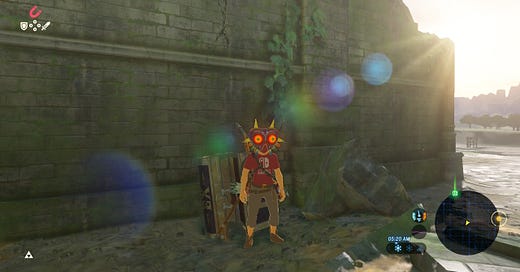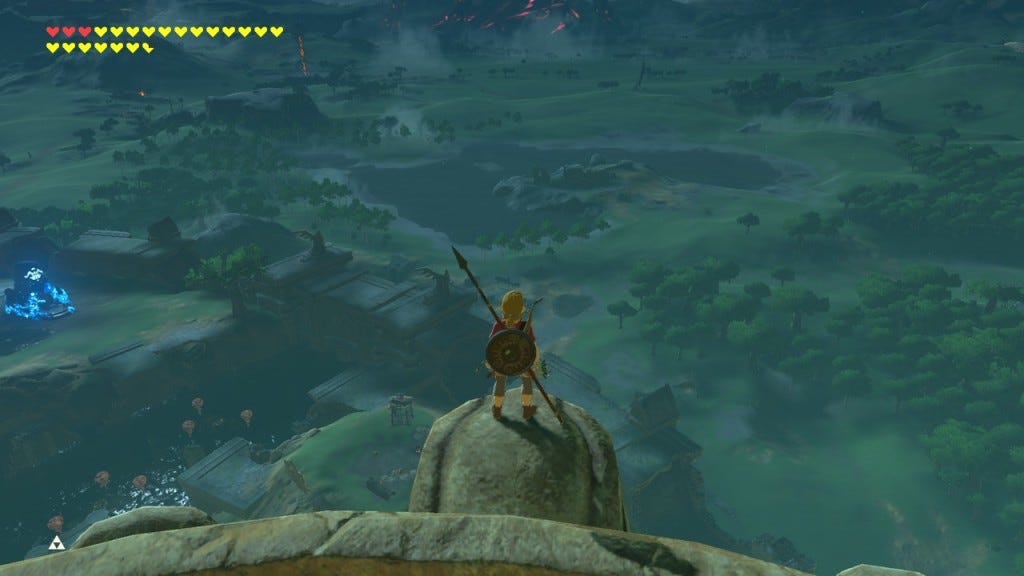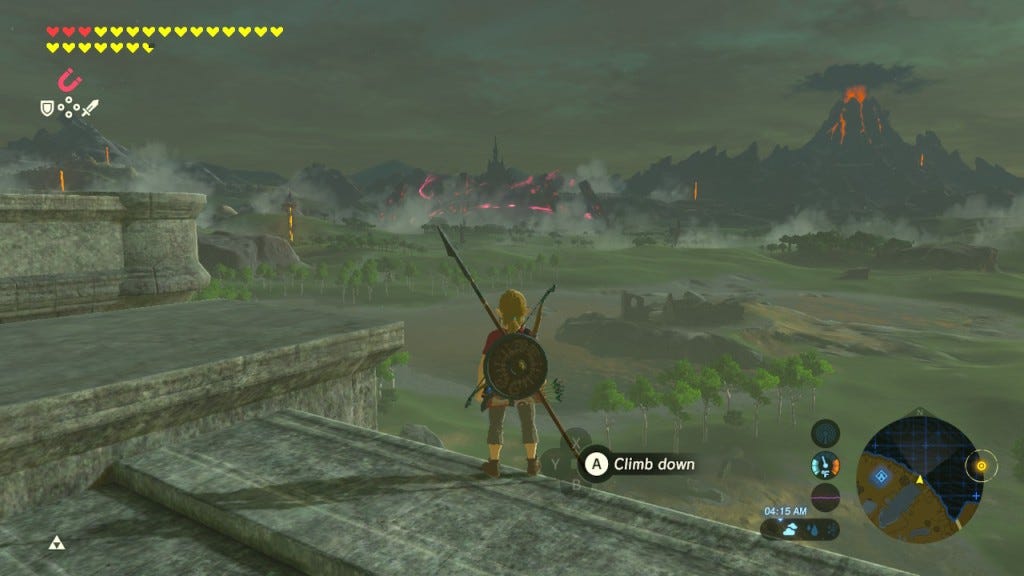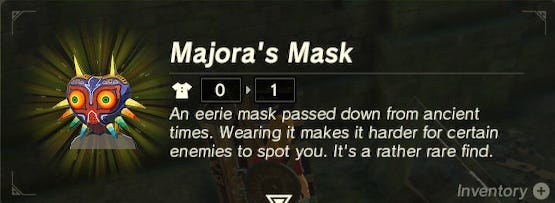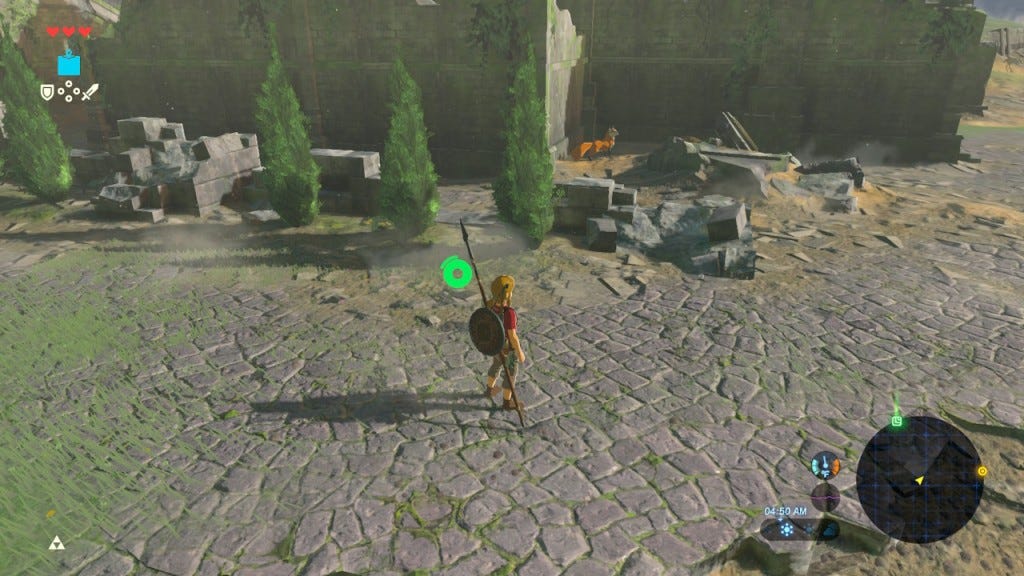Put A Fork In It
Out beyond ideas of wrongdoing and rightdoing,
there is a field. I’ll meet you there.When the soul lies down in that grass,
the world is too full to talk about.
Ideas, language, even the phrase ‘each other’
doesn’t make any sense.Rumi (sourced from National Poetry Day U.K.)
I'll tell ya, it's been a hell of a year. Don't even get me started, okay? Talk about a sucker punch! It trotted in here with an appealing name like "2022" (all 2s, it must be lucky, like 11:11, right? Make a wish!) and then it...unfolded as it did. Honestly, I can't speak for your experience of the year, so let's change the subject to something more universally relevant, shall we?
Here's a question: Are you actually ready to leave The Great Plateau? The first post in this series ended at what, at the time, I labeled "The Crossing of the First Threshold" in the sense of a particular stage of The Hero's Journey. Insofar as Link had just received his Main Quest from King Rhoam/The Old Man/Odin/Santa Claus, as well as the means to leave The Great Plateau, that's true. However, I've also spent two additional posts going back to cover more of the ground on The Great Plateau, leading all the way up to my decision (detailed in the previous post) to start the game over. One thing I didn't mention was how different my second experience of The Great Plateau was as compared with the first. The first time through, I was in a hurry, laser-focused on completing the tasks necessary to get out of there on the double. The second time, since it was the realization of everything I was missing the first time that made me go back and re-do it all in the first place, I took my time. The difference was like night and day. Let's put it this way: By the time I left the Plateau the second time and went to sell all my loot, I was left with more money at that early point in the game than I previously had after opening up half the map and freeing 2 of the 4 Divine Beasts. That is a huge difference! Of course, a big part of the difference was that, the first time, I didn't even know what I was doing and wouldn't have understood half of what to look for and where; the second time, I left the Plateau a relatively rich man despite spending about the same amount of clock-time there. There's a reason I bring this up: It's because, unless you have The Champion's Ballad EX, you will have no compelling reason to return to The Great Plateau and could just as well forget it entirely; best, then, to leave now with everything you'll want to take with you.
Besides, the Great Plateau housed 4 trials, setting up the foundational importance of that number as a symbol in this game; so even though King Rhoam has handed us our paraglider and pointed to the East, I'm going to slot in one more post before we symbolically take our journey beyond the edge. Hey, sometimes, we all have cold feet and hesitate to take that leap.
Warning! SPOILERS for The Legend of Zelda: Breath of the Wild from here on out!
I Walk The Thinnest Line
In Don Webb's upcoming book, How to Become a Modern Magus: A Manual for Magicians of All Schools (be sure to read my review here), he opens the chapter pertaining to January by introducing the concept of masks, which becomes the primary symbol used to build the proceeding curriculum. He specifically places the mask in the context of shamanism ("shaman" is the fourth word in the first sentence of the chapter), which will also be important here as we proceed. The mask is, as Webb explains, an example of a "barrier cue," the essence of this chapter. A barrier cue is some kind of trigger (typically in a physical form, from the mask already mentioned to something like a physical gateway or fence) that signals a transition from one state of being to another. Another upcoming barrier cue would be Midnight between New Year's Eve and New Year's Day. Today we're going to look at the barrier cue now facing Link. As it turns out, there's a perfect vantage point to utilize for the purposes of illustration, and I just discovered it this morning when I began doing some preliminary map research for this post. It's a little spot at the Northeast Corner of The Great Plateau (which—you'll note—is an artificial plateau defined by stone walls, or in other words, masonry). This will act as an "echo" of my warning above to be sure you're really ready to leave this place; have you learned everything it has to teach you?)
The initial clue pointing to this place, as I pointed out myself in the initial post, is that the steeple has large openings in the walls that Link is facing as he is given the quest: One facing East, one facing North. However, there is an interesting and symbolically relevant item (if you have The Champion's Ballad) that one can pick up immediately upon leaving The Great Plateau; teleporting to the Plateau's Sheikah Tower this morning to take a screenshot from there with the location of this item circled, I noticed for the first time that the architecture near the edge of the Plateau in the item's direction actually seems to specifically frame that spot; the best place to stand and paraglide to the item in question would be right in between two stone eagles, right next to the Bokoblin camp I mentioned in the previous post. Now I can't unsee it! How did I miss this? Oh, yeah: By being in a big hurry. Anyway, I glided down to that spot and was pleased as punch at how things looked from there; almost perfectly designed to make the very point I had wanted to make with this post! Better than the plan I had this morning, by leaps and bounds.
Do The Right Thing
At this point in the game, there is only one "right" thing to do; whether or not we actually feel inclined to do it ourselves, everyone knows what Link is meant to do here: Head due East, as King Rhoam advised, right through and past the Dueling Peaks. The "wrong" thing to do would be to blow King Rhoam off entirely and go do whatever we want to do. Between those two choices is a sort of grey area, not necessarily "wrong" in that we're still going to work our way to Kakariko, but not exactly "most right," because Calamity Ganon is a serious threat, so we shouldn't waste time.
As it happens, this vantage point overlooks a three-way crossroads that stands as the perfect symbol for Link's situation as described above (with Link's position marked by the red scribble):
"Gatepost Town Ruins" is a ghost town, currently patrolled by still more Moblins and Bokoblins; it looks really cool from the rim of The Great Plateau. Wouldn't we just love to explore it? But not now, right? For one, we have places to be, but even if we didn't, we wouldn't want to get our asses kicked. We might still be a little wet behind the ears, huh? Still, cool name for such a magical place.
On my first playthrough (not that it would have mattered, as I didn't have The Champion's Ballad EX anyhow), I did exactly as I was told and followed the road's "Eastern" branch (I use the air quotes because in the above image, it's dipping toward the South, but it eventually goes straight through The Dueling Peaks) until I got distracted by Dueling Peaks Tower. Out of curiosity, I decided to stand at my little "threshold" spot and admire the view if I faced due East: Pretty nice. This is where we need to be going:
The opposite way—facing out toward the Kingdom of Hyrule over the cliff's edge, it would be the path going off to the left/West—is blocked by one of the eagle statues. Even if I go past it, then the view is obscured in other ways. I have to wander quite a ways from this special spot to even see what that path holds. Given all of the forces commanding Link's attention, I can confide that on my first playthrough, going that way was never even a thought in my mind. However, I now call that direction "The Royal Road," for reasons I will discuss in a later post.
Next, I decided to scope out the view facing due North from Link's little spot. This view is interesting and will take some parsing. The first thing I find notable is how Hyrule Castle—our ultimate, over-arching destination, Link's destiny—lines up perfectly with the center of the screen and with Link himself:
Death Mountain, the primary background figure in the Northerly direction that has thus far stood out in any view looking in that direction from up here on The Great Plateau, is off to the right; farther North, basically off in the distance right behind Hyrule Castle, is an even more important and mysterious spot that Link can't even imagine at the moment; it is the spot I dreamed about before I ever played this game.
Perhaps, then, it's all the more meaningful that the special item I've been alluding to is found in this Northerly direction, right next to some ruins beside Lake Kolomo (the spot it marked in yellow on the map above). It's so close that you can literally paraglide right to it, pick it up, and be on your merry way—whichever way that might be.
Majora's Mask
Longtime fans of the Zelda franchise will recognize Majora's Mask; like most of the other special armor pieces added for the Champion's Ballad EX DLC, it's a nod to another Zelda game, and this one just might be the most popular for reasons having nothing to do with its awesome power in this game. I certainly know it by sight, although I must confess that I've never played the game it's from, which was a pseudo-sequel to Ocarina of Time, one of the franchise's best-known entries. I remember my cousin (one of the few people with whom I have ever shared the dual passions of Zelda and magic(k)) telling me I really needed to play that game; maybe some day. Right now, I am busy.
On my current playthrough, I had to chuckle when I noticed there was a fox sniffing around the chest as I went to pick it up—I'm gonna be all whiteboy/culturally-appropriational and say that Fox is my Spirit Animal; I'll get away with it because I am talking about a video game.
Majora's Mask will probably fade largely into the background after this post, but the role it plays will be central to everything else that unfolds, because it's eventually going to find its way to a central place in the magic(k)al paradigm beginning to emerge through these posts.
Regarding masks, Webb says in Modern Magus that when we don a mask, magically speaking, we become the god/figure represented by it, so now is a good time to link to some lore surrounding Majora. Webb also mentions in relation to barrier cues that we know, when entering the space defined by them, that the rules are changing. This applies acutely to Majora's Mask. What happens when you wear this mask?
It's interesting that this post comes immediately after the one where I brought up cheat codes/The Game Genie, because Majora's Mask is probably the closest thing to it that you'll get without modding your Nintendo Switch or playing this game on an emulator. When you put this mask on, most monsters (Bokoblins, Moblins, Lizalfos, and even, to some extent, Lynels) will not attack you. They'll instead confuse you for one of them. They will be curious and know something's up—they'll walk right up to you and sniff you—but unless you take a swing at them, you'll be safe from them. This is effective in-game invulnerability. And one of the coolest things about the fact that Hyrule Castle was directly in line with the North Pole as seen from that spot up on the Plateau is that it's probably the best place to go stock up on weapons—and with Majora's Mask, most of the monsters patrolling its halls will let you walk right out with them.
That's pretty close to cheating, isn't it? I mean...if you have this mask, what point is it even having swords? Well, kiddo, that's part of the turf when you're playing an open world game; you've been let off The Great Plateau, you're a big boy now; you can be given this tool and you can use it however you see fit. You will be responsible for the results. You have it; should you use it?
It is, by definition, not technically cheating because it is programmed into the game. It is, however, potentially cheap; but it's your game and if you want to spoil it by entirely removing the very mechanic that gives any of this meaning by providing some kind of risk/something to lose, you can be my guest.
There are other uses, however, and we will be discussing them soon. For now, we'll simply lay down some of the basic theory:
This mask is already tied to the role of the shaman. One of the defining characteristics of the shaman in pretty much any culture where it arises is that the shaman goes wherever he/she/they want(s). That's their defining feature, it's the meaning of their role: To travel freely between the worlds, interceding with spirits to get shit done. While wearing Majora's Mask, no, the usual rules do not apply. Link enters Liminal Space (LS) and during such time, his actions are not to be considered as part of the story of the phenomenal world; he steps outside of the narrative, too.
Can this be used for real-world sorcery?


